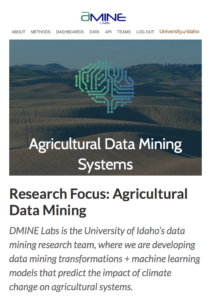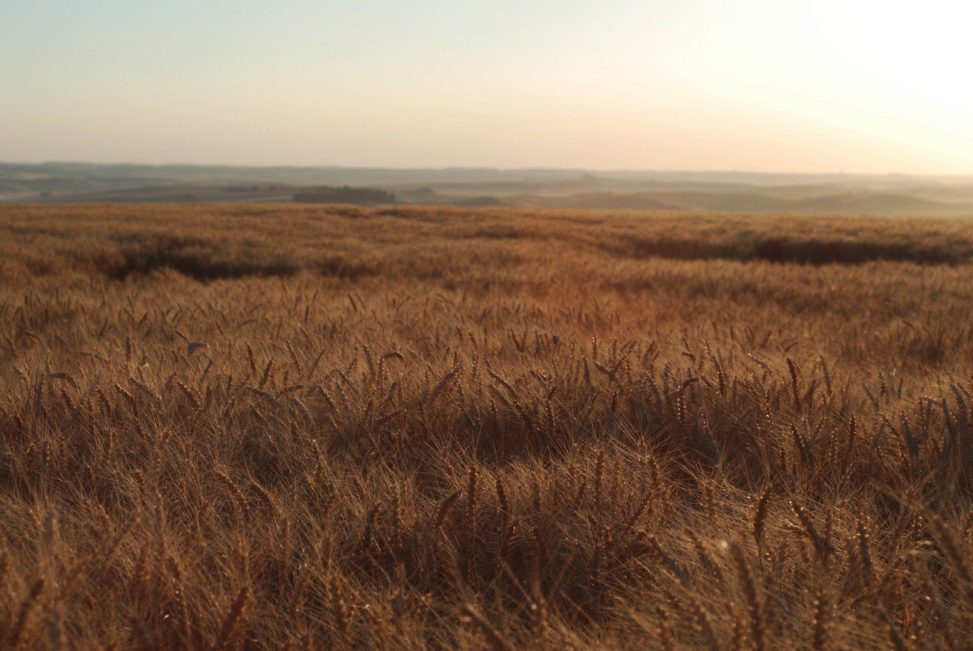- Home
- /
- Research

Research Area 1: Climatic analysis, data mining, and agriculture
As part of my PhD research, I’m exploring how variations in climatic processes can be understood thru the use of data mining and machine learning approaches for predictive threshold analysis (Maimon and Rokach, 2014, King et al 2015). I’m specifically focusing on agricultural commodity systems and insurance losses. The USDA has an extensive archive of insurance claim information, aggregated at a county and monthly level, with cause of damage (drought, heat, failure of irrigation supply, etc). My research is exploring how this extensive dataset, in combination with a variety of other climatic factors – can be used to construct a usable predictive agricultural commodity loss model.
As an integrated effort using the above concepts, I’m also working to develop a modular architecture API for data science integration, with a focus on climatic processes and machine learning algorithm use.
Climatic Analysis Research Abstract
Agricultural systems are an essential and growing aspect of our society. Not only is agriculture going through a data-centric revolution (Smith and Katz, 2013), the methods and analysis approaches for such efforts are also becoming much more complex (Gray, 2006, Bell, 2009, Clarke, 2009, Maimon and Rokach, 2010). Precision agriculture systems, cloud-based data assembly for farmers, and machine learning algorithms for predictive analytics, are all example areas of scientific discovery that are pushing efficient agricultural systems forward. This research builds upon this data growth, through the development of a modular data mining and machine learning methodology, initially focused on agricultural systems. The proposed methodology will be applied to 1) irrigated and 2) dryland agricultural systems in the Pacific Northwest region, stepping thru the processes of data assembly and geographic characterization, feature transformation and engineering, classifier/regressor selection, optimization, tuning, and finally, incorporation into a custom application programming interface (API). Each model and API will use climate outcomes to predict agricultural crop loss, estimating the influence of these changing conditional relationships over time. (e.g. how influential is drought on crop loss for a particular county, and does that influence change into the future?). Finally, the API, models, and analytics are integrated into a technology platform for access by land managers, farmers, or scientists, with the added capability of extending the methodology to other climate impact areas, such as health or land subsidence.
The research question focuses on agricultural systems and their impact given a changing climate. In this methodology example, we explore crop insurance claim losses that are submitted to the USDA , and how these data might be associated with climate data for a related time period.
Related Publications
Thornton, P. K., Jones, P. G., Alagarswamy, G., & Andresen, J. (2009). Spatial variation of crop yield response to climate change in East Africa. Global Environmental Change, 19(1), 54–65.
Smith, A. B., & Katz, R. W. (2013). US billion-dollar weather and climate disasters: Data sources, trends, accuracy and biases. Natural Hazards, 67(2), 387–410. http://doi.org/10.1007/s1106
Schlenker, W., & Roberts, M. J. (2009). Nonlinear temperature effects indicate severe damages to U.S. crop yields under climate change. Proceedings of the National Academy of Sciences, 106(
S, A. et al. (2013). Quantifying uncertainties in simulating wheat yields under climate change. Nature Climate Change, 64, 49–67. http://doi.org/10.1258/itt.2010.100803
Ray, D. K., Gerber, J. S., MacDonald, G. K., & West, P. C. (2015). Climate variation explains a third of global crop yield variability. Nature Communications, 6, 5989. http://doi.org/10.103
Mclain, K., & Castro, H. (2015). Interim Report : 2015 Drought and Agriculture A Study by the Washington State Department of Agriculture, (December), 38.
Lobell, D. B., & Burke, M. B. (2010). On the use of statistical models to predict crop yield responses to climate change. Agricultural and Forest Meteorology, 150(11), 1443–1452. http://doi.org/10.1016/j.agrformet.2010.07.008
Lobell, D. B., Schlenker, W., & Costa-Robert, J. (2011). Climate trends and global crop production since 1980. Science, 333(2011), 616–620. http://doi.org/10.1126/science.1204531
Lobell, D. B., Burke, M. B., Tebaldi, C., Mastrandrea, M. D., Falcon, W. P., & Naylor, R. L. (2008). Prioritizing Climate Change Adaptation Needs for Food Security in 2030. Science, 319(586
Gornall, J., Betts, R., Burke, E., Clark, R., Camp, J., Willett, K., & Wiltshire, A. (2010). Implications of climate change for agricultural productivity in the early twenty-first century. Philosophic
EPA. (2015). Climate Change in the United States: Benefits of Global Action. United States Environmental Protection Agency, Office of Atmospheric Programs, EPA, 93p.
 Research Area 2: Child development and GIS
Research Area 2: Child development and GIS
Im also working on a line of research with several other researchers in the areas of child psychology, to explore inter-relationships between location and how children are effected. We have several studies examining the relationship of crime to child temperament and biophyiscal markers:
Gartstein, M.A., E. Seamon, T. Dishion. GEOSPATIAL ECOLOGY OF ADOLESCENT PROBLEM BEHAVIOR: CONTRIBUTIONS OF COMMUNITY FACTORS AND PARENTAL MONITORING – Journal of Community Psychology, March 2014
Gartstein, MA, E. Seamon, L. Lengua. Community Crime Exposure and Risk for Obesity in Preschool Children: Moderation by the Hypothalamic–Pituitary–Adrenal (HPA)-Axis. Journal of Pediatric Psychology 2017


